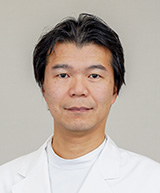Researchers

- MINAMI Yasunori
- Lecturer in Medical School
| Faculty | Department of Medicine |
|---|---|
| Researchmap | https://researchmap.jp/read0076806 |
Education and Career
Education
- - 1997 , Kindai University, Faculty of Medicine,
- - 1997 , Kinki University, Faculty of Medicine,
- - 2003 , Kindai University, Graduate School of Medical Sciences,
Research Activities
Research Areas
- Life sciences, General surgery, pediatric surgery
- Life sciences, Gastroenterology
Research Interests
Liver metastasis, 肝動脈塞栓術, ラジオ波焼灼術, 造影超音波, 肝細胞癌, Radiofrequency ablation, Contrast-enhanced sonography, Hepatocellular Carcinoma
Published Papers
-
Molecular Classification of Hepatocellular Carcinoma based on Zoned Metabolic Feature and Oncogenic Signaling Pathway.
Tomoko Aoki; Naoshi Nishida; Yutaka Kurebayashi; Kazuko Sakai; Naoto Fujiwara; Masakatsu Tsurusaki; Kohei Hanaoka; Masahiro Morita; Hirokazu Chishina; Masahiro Takita; Satoru Hagiwara; Hiroshi Ida; Kazuomi Ueshima; Yasunori Minami; Atsushi Takebe; Takaaki Murase; Keiko Kamei; Takuya Nakai; Ippei Matsumoto; Kazuto Nishio; Masatoshi Kudo
Clinical and molecular hepatology 11, Mar. 2025 , Refereed -
Proposal of discontinuation criteria of atezolizumab plus bevacizumab after curative conversion therapy for unresectable early-to-intermediate-stage hepatocellular carcinoma: a multicenter proof-of-concept study.
Tomoko Aoki; Masatoshi Kudo; Naoshi Nishida; Kazuomi Ueshima; Kaoru Tsuchiya; Toshifumi Tada; Masahiro Morita; Hirokazu Chishina; Masahiro Takita; Satoru Hagiwara; Hiroshi Ida; Yasunori Minami; Hidekatsu Kuroda; Noriaki Nakamura; Atsushi Hiraoka; Tetsu Tomonari; Joji Tani; Atsushi Naganuma; Satoru Kakizaki; Chikara Ogawa; Takeshi Hatanaka; Toru Ishikawa; Kazuhito Kawata; Atsushi Takebe; Ippei Matsumoto; Masaaki Hidaka; Masayuki Kurosaki; Takashi Kumada; Namiki Izumi
Journal of gastroenterology 7, Mar. 2025 -
Two Distinct Characteristics of Immune Microenvironment in Human Hepatocellular Carcinoma with Wnt/β-Catenin Mutations.
Tomoko Aoki; Naoshi Nishida; Yutaka Kurebayashi; Kazuko Sakai; Masahiro Morita; Hirokazu Chishina; Masahiro Takita; Satoru Hagiwara; Hiroshi Ida; Kazuomi Ueshima; Yasunori Minami; Masakatsu Tsurusaki; Takuya Nakai; Michiie Sakamoto; Kazuto Nishio; Masatoshi Kudo
Liver cancer 13 (3) , 285-305, Jun. 2024
Books etc
- 肝癌診療マニュアル 第2版, 肝癌の治療 肝癌治療の実際 内科的局所治療 ラジオ波焼灼療法 RFAの適応と除外基準 造影超音波下RFA. , 南 康範; 工藤 正俊 , 医学書院, 東京 , 2010
- 今日の消化器疾患治療指針 第3版, 科学的根拠に基づく肝癌診療ガイドライン. , 南 康範; 工藤 正俊 , 医学書院, 東京 , 2010
- 講義録 腫瘍学 メジカルビュー社, 東京, 画像検査. , 南 康範; 工藤 正俊 , 2009
Conference Activities & Talks
- US-US overlay image fusionを用いたラジオ波焼灼術の有用性:従来治療との比較 , 南 康範; 工藤 正俊 , 第53回 日本肝癌研究会 , 6, Jul. 2017
- Precision RFAを目指して -可変型電極ができること- , 南 康範 , 第53回 日本肝臓学会 総会 , 8, Jun. 2017
- ラジオ波焼灼術後のバブルによる高エコー域を壊死部とみなして良いか? , 南 康範; 工藤 正俊 , 第90回 日本超音波医学会学術集会 , 25, May. 2017
MISC
- The usefulness of ultrasonography in small diameter hyperechoic nodule of the Kidney , 南雅人; 中村祐香; 江口香織; 片岡久紗; 横川美加; 市島真由美; 塩見香織; 南康範; 依田広; 工藤正俊 , 超音波医学 Supplement , 51 , 2024
- HCC inflamed classにおける遺伝子変異の頻度と術後再発率に関する検討 , 青木智子; 西田直生志; 紅林泰; 坂井和子; 萩原智; 上嶋一臣; 南康範; 坂元亨宇; 西尾和人; 工藤正俊 , 日本消化器病学会雑誌(Web) , 121 , 2024
- Application of abdominal ultrasonography in assessment of gastrointestinal cancer , 南雅人; 中村祐香; 江口香織; 片岡久紗; 横川美加; 市島真由美; 塩見香織; 南康範; 樫田博史; 工藤正俊 , 超音波医学 Supplement , 50 , 2023
Research Grants & Projects
- Study on evaluating of therapeutic effect in the earlier stape after transcatheter arterial chemembolization